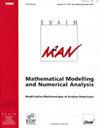Adaptive physical-constraints-preserving unstaggered central schemes for shallow water equations on quadrilateral meshes
IF 1.9
3区 数学
Q2 Mathematics
Esaim-Mathematical Modelling and Numerical Analysis-Modelisation Mathematique et Analyse Numerique
Pub Date : 2022-09-12
DOI:10.1051/m2an/2022076
引用次数: 1
Abstract
A well-balanced and positivity-preserving adaptive unstaggered central scheme for two-dimensional shallow water equations with nonflat bottom topography on irregular quadrangles is presented. The irregular quadrilateral mesh adds to the difficulty of designing unstaggered central schemes. In particular, the integral of the source term needs to subtly be dealt with. A new method of discretizing the source term for the well-balanced property is proposed, which is one of the main contributions of this work. The spacial second-order accuracy is obtained by constructing piecewise bilinear functions. Another novelty is that we introduce a strong-stability-preserving \emph{Unstaggered-Runge-Kutta} method to improve the accuracy in time integration. Adaptive moving mesh strategies are introduced to couple with the current unstaggered central scheme. The well-balanced property is still valid. The positivity-preserving property can be proved when the cells shrink. We prove that the current adaptive unstaggered central scheme can obtain the stationary solution (``lake at rest" steady solutions) and guarantee the water depth to be nonnegative. Several classical problems of shallow water equations are shown to demonstrate the properties of the current numerical scheme.四边形网格浅水方程的自适应保持物理约束的不交错中心方案
针对不规则四边形上具有非平坦底地形的二维浅水方程,提出了一种平衡良好、保正的自适应不交错中心格式。不规则的四边形网格增加了设计不交错中心方案的难度。特别地,源项的积分需要巧妙地处理。本文提出了一种对源项进行均匀性离散化的新方法,这是本工作的主要贡献之一。通过构造分段双线性函数获得空间二阶精度。另一个新颖之处在于我们引入了一种强保稳定的\emph{非交错龙格-库塔}方法来提高时间积分的精度。引入自适应移动网格策略,与现有的不交错中心方案相结合。平衡性仍然有效。当细胞收缩时,可以证明其保正性。证明了现有的自适应不交错中心方案能够获得平稳解(“静止的湖”稳定解)并保证水深非负。用几个经典的浅水方程问题来说明当前数值格式的性质。
本文章由计算机程序翻译,如有差异,请以英文原文为准。
求助全文
约1分钟内获得全文
求助全文
来源期刊

CiteScore
2.70
自引率
5.30%
发文量
27
审稿时长
6-12 weeks
期刊介绍:
M2AN publishes original research papers of high scientific quality in two areas: Mathematical Modelling, and Numerical Analysis. Mathematical Modelling comprises the development and study of a mathematical formulation of a problem. Numerical Analysis comprises the formulation and study of a numerical approximation or solution approach to a mathematically formulated problem.
Papers should be of interest to researchers and practitioners that value both rigorous theoretical analysis and solid evidence of computational relevance.
 求助内容:
求助内容: 应助结果提醒方式:
应助结果提醒方式:


